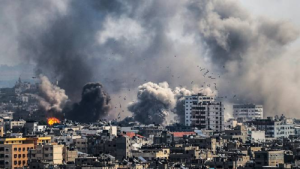
The morgue at Gaza’s biggest hospital has overflown as bodies come in faster than relatives could claim them on the seventh day of Israel’s heavy aerial bombardment on the besieged Palestinian enclave of 2.3 million people.
The morgue at Gaza City’s Shifa hospital can only handle some 30 bodies at a time, and workers had to stack corpses three high outside the walk-in cooler and put dozens more, side by side, in the parking lot.
Some were placed in a tent, and others were sprawled on the cement, under the sun.
“The body bags started and just kept coming and coming and now it’s a graveyard,” Abu Elias Shobaki, a nurse at Shifa, said of the parking lot on Thursday.
“I am emotionally, physically exhausted. I just have to stop myself from thinking about how much worse it will get.”
An Israeli ground invasion would likely drive up the Palestinian death toll, which already has outpaced the past four bloody wars between Israel and Palestine.
The sheer volume of human remains has pushed the system to its limit in the long-blockaded enclave.
Gaza’s hospitals are poorly supplied in normal times, but now Israel has stopped the water flow from its national water company and blocked electricity, food and fuel from entering the coastal enclave.
“We are in a critical situation,” said Ashraf al Qidra, the spokesperson for the Gaza Health Ministry.
“Ambulances can’t get to the wounded, the wounded can’t get to intensive care, the dead can’t get to the morgue.”
Lines of white body bags — soles of bare feet sticking out from one, a bloodied arm from another — brought the scale and intensity of Israel’s bombardment on Gaza into sharp focus.
Hospital officials asked stricken family members to identify their loved ones.
Some peered into the body bags, then collapsed into tears or screams.

As Israel rains death on besieged Gaza, anti-Palestine users try to dominate the narrative and set the news agenda by hawking doctored visuals, tampered articles and unverified news on social media — a pattern seen in every Israel-Palestine war.
READ: Trolls, Islamophobes, sham experts inflame social media as bombs hit Gaza

As Israel-Palestine war reaches its seventh day, Israeli military pulverises besieged Gaza with air strikes ahead of a possible ground invasion with civil defence workers still pulling bodies from the rubble and counting the dead.
READ: Live blog: Israel warns 1.1 million Palestinians in Gaza to relocate south.
Israeli influencer Matanel Laiany shared a video mocking Palestinians for not having water and electricity due to Israel’s full-fledged blockade on Gaza, captioning it ‘this is just the beginning’ pic.twitter.com/idvH5EukoZ
— TRT World (@trtworld) October 12, 2023
Patients in streets
Israel’s campaign on besieged Gaza has levelled entire neighbourhoods, killing over 1,500 people, more than 60 percent of them women and children, according to the Gaza Health Ministry.
More than 420,000 have been displaced — 16 percent of Gaza’s population.
Israeli air strikes pummeled the heart of Jabaliya refugee camp, killing dozens of people — including 45 members of the same extended family, Gaza’s Interior Ministry said.
The Israeli military says it is striking Hamas infrastructure and aims to avoid civilian casualties, but visuals and testimonies from Gaza tell a different story.
The deaths, and over 6,000 wounded, have overwhelmed Gaza’s healthcare facilities as supplies dwindle.
“It is not possible, under any circumstances, to continue this work,” said Mohammad Abu Selim, Shifa’s general director.
“The patients are now on the streets. The wounded are on the streets. We cannot find a bed for them.”
With resources stretched thin, clinics understaffed and ambulances taking hours to get victims to medical care because air strikes have ravaged the streets, some say it’s not worth the trip.
“We know that if a case is critical, they just won’t survive,” said Khalil Abu Yehiya, a 28-year-old teacher from the Jabaliya refugee camp in northern Gaza, whose neighbour’s home was bombed on Thursday in a deadly assault that residents said killed many members of the same extended family.

Israeli occupation of Palestinian lands, which have been turned into open-air prisons by Tel Aviv for decades, have nothing to do with any ‘moral clarity’.
READ: Did Netanyahu and Blinken just declare modern-day colonial onslaught?
Palestinian man calls on the world to help as he stands in the midst of the bombed-out neighbourhood of Al Karama, north of Gaza City. He condemns Israel for using banned white phosphorus on civilians pic.twitter.com/NS9sZMrYes
— TRT World (@trtworld) October 12, 2023
‘Not this level of insanity’
When more heavy bombardment hit the Shati refugee camp just north of Gaza City along the Mediterranean coast on Thursday, a new wave of wounded streamed into the hospital complex — toddlers with bruises and bandages, men with makeshift tourniquets, young girls with blood caked on their faces.
Because Shifa’s intensive care unit was full, some lay in the hospital corridors, pressed up against the walls to clear aisles for staff and stretchers.
“I’ve been to many places and seen horrors and shelling. Not this level of insanity,” said 36-year-old local photojournalist Attia Darwish as he watched the wounded pour into Shifa Hospital.
Among those killed in the strikes on Shati refugee camp was Yasser al Masri, whose body arrived along with those of his wife and infant daughter.
His friends shared his final Facebook post just hours before Israel’s warplanes struck.
“I only have a few hours before my phone dies because we’re without electricity,” he wrote.
“There is no light at night except the moon. Please forgive me. I forgive all of you.”
Gaza’s sole power plant ran out of fuel on Wednesday.
Shifa and other hospitals were desperately trying to save whatever diesel remained in their backup generators, turning off the lights in all hospital departments but the most essential — intensive care, operating rooms, oxygen stations.
Abu Selima, director of Shifa, said the last of the hospital’s fuel would run out in three or four days.
When that happens, “a disaster will occur within five minutes,” said Naser Bolbol, head of the hospital’s neonatal department, citing all the oxygen equipment keeping infants alive.
A leaked video from 2001 shows Israeli PM Netanyahu talking about how Israel intentionally strikes Palestinians “painfully”, how he deceived the US to break the Oslo Accords, and how Americans will always support Israel if it faces backlash pic.twitter.com/Y8FkHn7b2Z
— TRT World (@trtworld) October 10, 2023
Source: TRT World. 13 Oct 2023